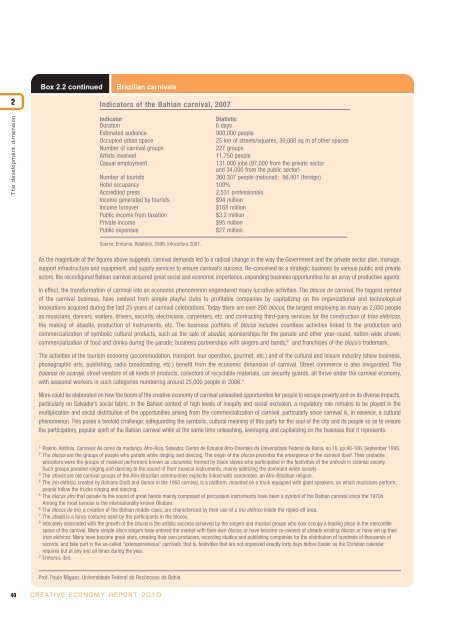Creative Economy: A Feasible Development Option
Creative Economy: A Feasible Development Option
Creative Economy: A Feasible Development Option
- No tags were found...
You also want an ePaper? Increase the reach of your titles
YUMPU automatically turns print PDFs into web optimized ePapers that Google loves.
2Box 2.2 continuedBrazilian carnivalsIndicators of the Bahian carnival, 2007The development dimensionIndicatorStatisticDuration6 daysEstimated audience900,000 peopleOccupied urban space25 km of streets/squares, 30,000 sq m of other spacesNumber of carnival groups227 groupsArtists involved11,750 peopleCasual employment131,000 jobs (97,000 from the private sectorand 34,000 from the public sector)Number of tourists360,307 people (national); 96,401 (foreign)Hotel occupancy 100%Accredited press2,531 professionalsIncome generated by tourists$94 millionIncome turnover$168 millionPublic income from taxation$3.2 millionPrivate income$95 millionPublic expenses$27 millionSource: Emtursa, Relatório, 2006; Infocultura 2007.As the magnitude of the figures above suggests, carnival demands led to a radical change in the way the Government and the private sector plan, manage,support infrastructure and equipment, and supply services to ensure carnival’s success. Re-conceived as a strategic business by various public and privateactors, the reconfigured Bahian carnival acquired great social and economic importance, expanding business opportunities for an array of productive agents.In effect, the transformation of carnival into an economic phenomenon engendered many lucrative activities. The blocos de carnival, the biggest symbolof the carnival business, have evolved from simple playful clubs to profitable companies by capitalizing on the organizational and technologicalinnovations acquired during the last 25 years of carnival celebrations. Today there are over 200 blocos, the largest employing as many as 2,000 peopleas musicians, dancers, waiters, drivers, security, electricians, carpenters, etc. and contracting third-party services for the construction of trios elétricos,the making of abadás, production of instruments, etc. The business portfolio of blocos includes countless activities linked to the production andcommercialization of symbolic cultural products, such as the sale of abadás; sponsorships for the parade and other year-round, nation-wide shows;commercialization of food and drinks during the parade; business partnerships with singers and bands; 8 and franchises of the bloco’s trademark.The activities of the tourism economy (accommodation, transport, tour operation, gourmet, etc.) and of the cultural and leisure industry (show business,phonographic arts, publishing, radio broadcasting, etc.) benefit from the economic dimension of carnival. Street commerce is also invigorated. Thebaianas de acarajé, street vendors of all kinds of products, collectors of recyclable materials, car security guards, all thrive under the carnival economy,with seasonal workers in such categories numbering around 25,000 people in 2006. 9More could be elaborated on how the boom of the creative economy of carnival unleashed opportunities for people to escape poverty and on its diverse impacts,particularly on Salvador’s social fabric. In the Bahian context of high levels of inequity and social exclusion, a regulatory role remains to be played in themultiplication and social distribution of the opportunities arising from the commercialization of carnival, particularly since carnival is, in essence, a culturalphenomenon. This poses a twofold challenge: safeguarding the symbolic, cultural meaning of this party for the soul of the city and its people so as to ensurethe participatory, popular spirit of the Bahian carnival while at the same time unleashing, leveraging and capitalizing on the business that it represents.1Risério, Antônio, Carnaval: As cores da mudança. Afro-Ásia, Salvador, Centro de Estudos Afro-Orientais da Universidade Federal da Bahia, no.16, pp.90-106, September 1995.2The blocos are the groups of people who parade while singing and dancing. The origin of the blocos precedes the emergence of the carnival itself. Their probableancestors were the groups of masked performers known as cucumbis, formed by black slaves who participated in the festivities of the entrudo in colonial society.Such groups paraded singing and dancing to the sound of their musical instruments, mainly satirizing the dominant white society.3The afoxés are old carnival groups of the Afro-Brazilian communities explicitly linked with candomblé, an Afro-Brazilian religion.4The trio elétrico, created by Bahians Dodô and Osmar in the 1950 carnival, is a platform, mounted on a truck equipped with giant speakers, on which musicians perform;people follow the trucks singing and dancing.5The blocos afro that parade to the sound of great bands mainly composed of percussion instruments have been a symbol of the Bahian carnival since the 1970s.Among the most famous is the internationally known Olodum.6The blocos de trio, a creation of the Bahian middle class, are characterized by their use of a trio elétrico inside the roped-off area.7The abadá is a fancy costume used by the participants in the blocos.8Intricately associated with the growth of the blocos is the artistic success achieved by the singers and musical groups who now occupy a leading place in the mercantilespace of the carnival. Many simple bloco singers have entered the market with their own blocos, or have become co-owners of already existing blocos, or have set up theirtrios elétricos. Many have become great stars, creating their own producers, recording studios and publishing companies for the distribution of hundreds of thousands ofrecords, and take part in the so-called “extemporaneous” carnivals, that is, festivities that are not organized exactly forty days before Easter as the Christian calendarrequires but at any and all times during the year.9Emtursa, ibid.Prof. Paulo Miguez, Universidade Federal do Recôncavo da Bahia.40 CREATIVE ECONOMY REPORT 2010
















